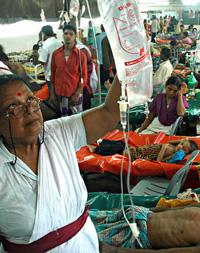BANGKOK, 31 January 2011 (IRIN) - From hip replacements to hysterectomies, southeast Asian countries have seen a
rapid growth in medical tourism, with about two million international patients a year seeking bargains there.
But according to the World Health Organization (WHO), medical tourism is leading to some highly skilled specialists, as well as other trained medical staff, leaving public health facilities for private ones. Further down the medical hierarchy unemployed or undertrained staff end up filling chronic shortages in remote areas.
Churnrurtai Kanchanachitra, a professor at Thailand’s Mahidol University and co-author of a recent paper on health worker shortages and the international trade in health services, warned of the dangers:
“There are five countries [in Southeast Asia] facing a shortage of health professionals, mostly in rural areas,” said Kanchanachitra. “This will only become a more pressing issue with the continued growth in trade in health services.”
Thailand reported US$1.4 billion in revenues from medical tourists in 2008 - about 30 percent from medical procedures and 50 percent from shopping. The national tourism authority has projected attracting 10 million medical tourists by 2015.
Over the past decade the Association of Southeast Asian Nations (ASEAN) has gradually liberalized trade in services, with health as one of the 11 priority areas. In 2001 member countries started negotiating mutual recognition arrangements to facilitate the migration of professionals, with the expectation that health workers could migrate easily by 2010.
The US-based trade group Medical Tourism Association estimates the value of global medical tourism will increase to $100 billion in 2012.
In total , Indonesia, Vietnam, Laos, Cambodia and Myanmar are short of nearly 250,000 health professionals to meet WHO minimum standards of care (covering 80 percent of births and measles immunizations), based on country data.
Brain drain?
In 2004 Indonesia was one of the top three places in Southeast Asia where health workers undertook training prior to seeking work in Organisation for Economic Co-operation and Development (OECD) countries, according to OECD.
Arina Nurfianti, a 26-year-old nurse teaching in Indonesia’s West Kalimantan Province (on the island of Borneo), said she wants to go abroad for more money and better work conditions if she can get the paperwork.
"I still do not have an international registered nurse certificate to allow me to work overseas. Many Indonesian nurses who work overseas do not have such a certificate, which is why many of them are working as assistants to nurses."
Nigel Crisp, a UK parliamentarian and doctor who has worked on issues of health worker training and global partnerships, concluded: “The trend is towards an increase in health worker migration, and the chance is weak that poor countries can benefit.” Knowledge gained working overseas, strengthened accreditation and remittances help, but may still leave poor countries benefiting less from migration, he said.
 Photo: Brennon Jones/IRIN  |
| Training remains a challenge |
Health worker migration forms a small part of the trade in health services, with e-health (e.g. medical transcription - the conversion of voice-recorded reports, as dictated by physicians and/or other healthcare professionals, into text format), medical tourism and health infrastructure investments forming the bulk of current trade, according to experts at a recent WHO meeting on the impact of trade in health services on human resources in health.
Training paramount
Current problems with health worker shortages worldwide cannot be blamed on migration alone.
“Migration is an issue, but it is not the biggest issue. In Africa some 135,000 health workers have emigrated [in recent decades] and there is a shortage of some 1.5 million health professionals. The biggest issue is how to improve training to fill that gap,” said Crisp.
He called on developed countries to form bilateral agreements with the countries from where they accept health worker migrants, and to invest in exporting countries' health systems and health worker training, and not set up alternative training institutions which could compete with, and wipe out, local ones.
UN member states adopted an international code of practice in May 2010 to promote the ethical recruitment of health personnel, protect migrating workers’ rights and minimize the negative effects of such migration, but it is voluntary, non-binding and difficult to enforce, said John Hancock, a World Trade Organization adviser.
“The global architecture [of trade in health services] promotes efficiency. That is the nature of capitalism. What is still missing in that architecture is how to work equity into the equation,” said Hancock.

No comments:
Post a Comment